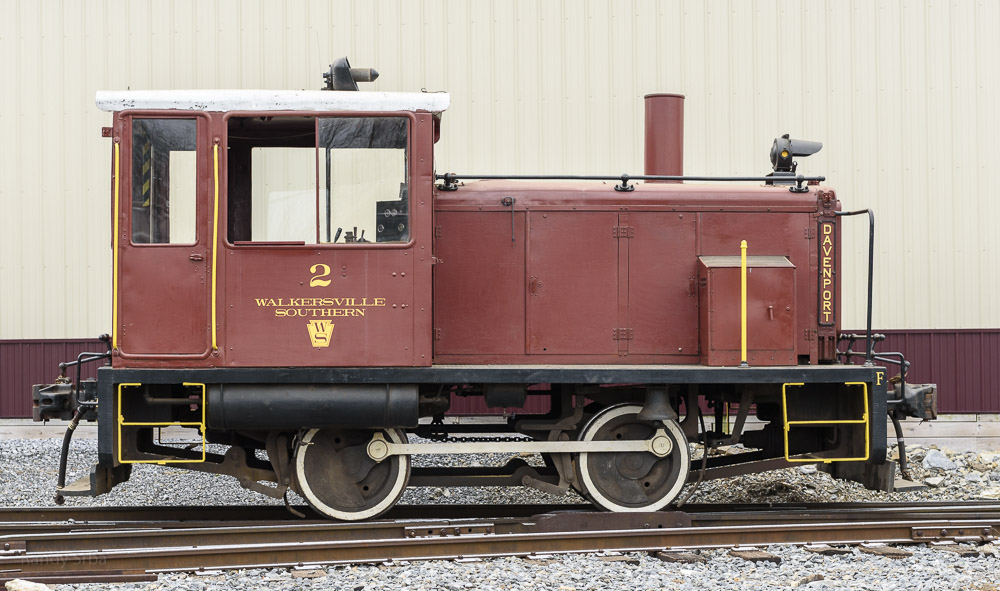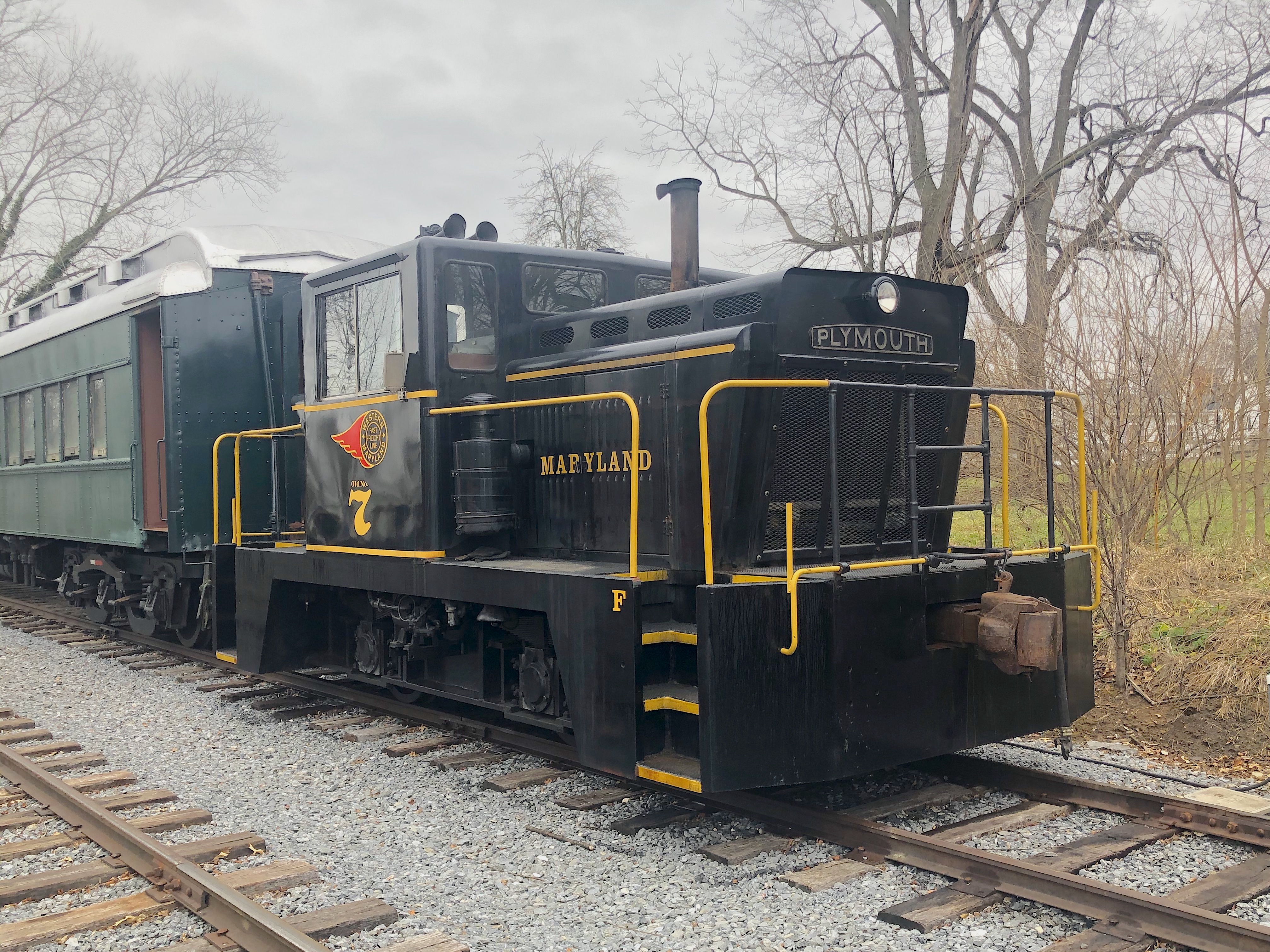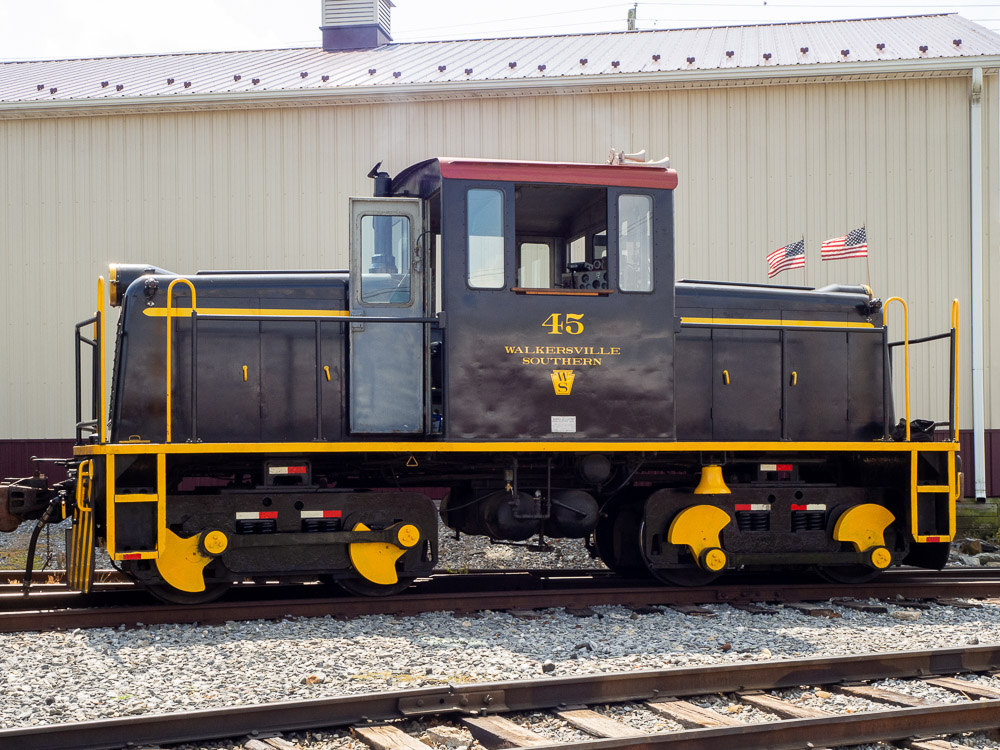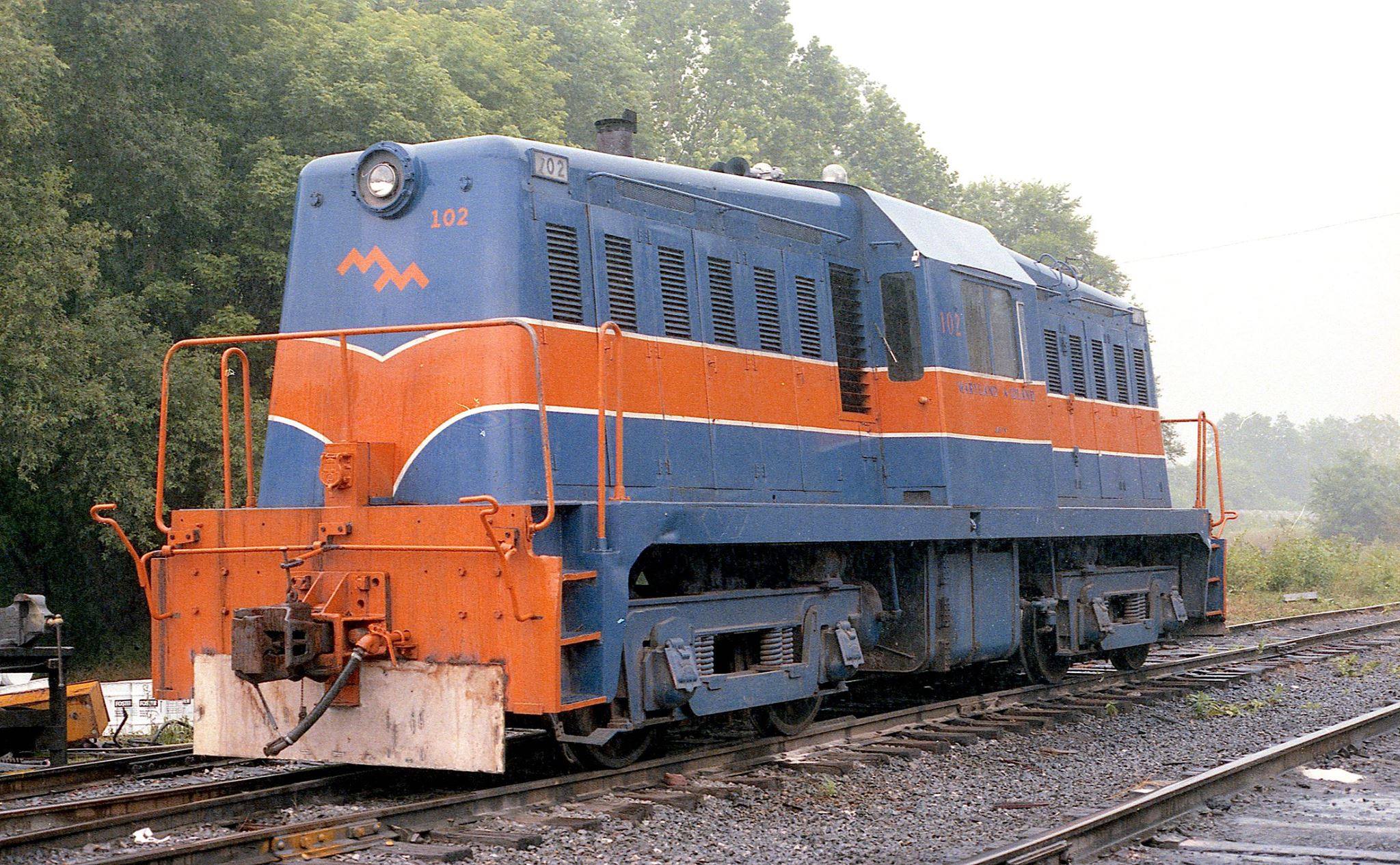Don't forget the McHugh Mack locomotive.
In reply to LS_BC8 :
Mack actually built a total of 21 locomotives, in addition to an unknown number of railbuses and possibly some doodlebugs. They ranged from 12 tons to 80 tons, and most were a gas-mechanical drive, using the same engines as Mack trucks of the era.

The big boxcabs, Mack #3 and #4, that McHugh donated were actually originally built as electric locomotives for Southwest Missouri Railroad Company by GE, and then when the Southwest Missouri went out of business they were shipped up to Mack's factory where they were rebuilt with generators and the Mack engines, making them the only 4-axle Mack locomotives built, and were used to switch cars at Mack's factory in Allentown. After retirement, they were sold to the Railways to Yesterday trolley museum in Rockhill Furnace PA and performed the last switching duties at the historic dual-gauge rail yards in Mount Union PA at the East Broad Top Railroad & Coal Co. Mack 4 during March of 1970 was moved to the NH&I where it was briefly used until its departure in January 1971. Mack 4 was then stored in Penndel, PA from 1971 until 1986, when the boxcab was transported by truck to the Wanamaker, Kempton & Southern in Kempton, PA where it rested on the ground for 22 years.
The other one, Mack 3 was also acquired by a Wanamaker. Kempton & Southern in Kempton, PA. The boxcab was renumbered as #35 and was briefly operated here for a few years until one of the engines blew up due to low oil level. The boxcab was operated on occasion with only one engine until an electrical fire occurred. The group then attempted to make repairs to the boxcab, but aborted the project. Unfortunately, the WK&S stripped both of the two rare boxcab’s of many valuable components, that were required to be keep the locomotives in operation. In 2008, WK&S was considering scrapping both of them, but McHugh Locomotive stepped up to the plate, bought both and parted the #3 out to make the #4 complete again.
Thieves in LA are breaking into shipping container trains, removing goods and leaving a dump behind. =~ (
914Driver said:Thieves in LA are breaking into shipping container trains, removing goods and leaving a dump behind. =~ (
I saw that. People suck. Union Pacific is asking city law enforcement to get involved in helping police the incidents, which is pretty unusual because railroad's are typically self-policing. Jalopnik wrote an article on the situation where, instead of blaming railroads like they always do whenever they write an article about railroads (see their articles about the Brightline deaths caused by people walking high-speed rails or bypassing crossing guards) they instead offered a weird apologist stance for the thieves. "Well, it's okay that their stealing because they're taking stuff they need that they can't get, and it's just corporations that they're stealing from, and berkeley them." No, in the case of Amazon packages, they're taking from people who legitimately bought and paid for their items, and when you are stealing from corporations aren’t going to just accept these losses, they will raise prices to compensate their losses and that hurts everyone. Also, I can almost excuse, or at least understand the mentality behind, stealing stuff like epipens, but to steal stuff like TVs to resell them is just being a plain scumbag.
Time for the railroad to start deputizing folk. A bunch of pissed off folks with scatterguns may make thieves think twice...
NickD said:The Walkersville Southern, in Walkersville, Maryland, has the #101 which was still routinely used to haul passengers until fairly recently, and is planned to return to service once they successfully overhaul the one 6-71 engine that began ailing.
The Walkersville Southern would be an interesting line to visit because their whole schtick is that they operate with a fleet entirely composed of industrial critters. In addition to an EMC Model 40, they have three GE 44-tonners, two GE side-rod 45-tonner, an 18-ton Plymouth, a 20-ton Davenport, a 25-ton side-rod Davenport that was built using a steam locomotive chassis, and a very-rare Plymouth CR-4 two-axle, 60-ton center cab.




In reply to NickD :
I like the tiny gas engine the J&L has, it doesn't look much longer than a speeder.
In reply to NickD :
The Walkerville Railroad is between me and Summit Point. That just made my spring list. My son William will flip for this.
We had one of these at work to move cannon from building to building on a flat bed. I saw it disassembled, damn pistons looked like coffee cans!

In reply to 914Driver :
The majority of them run a pair of Caterpillar D17000 engines, which have a 5.750" bore and an 8" stroke. There were also a handful of them built with other engines, nine with Hercules DFXD engines, ten with two Buda 6DH1742 engines, and the last four had Caterpillar D342 engines.
The Caterpillar D17000 engines are the Achilles heel of the GE 44-tonner. Caterpillar ended their major parts support for the D-17000 engine many moons ago, and the cylinder head design suffered from having a very narrow ligament between the valve seats which is prone to cracking into the cooling water space directly above. According to Kelly Anderson, former chief mechanical officer at Strasburg, they were never able to repair the heads on Strasburg's ex-PRR GE 44-tonner, #9331 now at Walkersville Southern, because any weld or braze repair would include the valve seats as well, and doesn’t correct the basic problem that causes the crack to form in the first place. He said they used up dozens of cylinder heads over the years, culled from scrapped GE 44-tonners and power generators and irrigation pumps, and the last straw was when it cracked another cylinder head and someone sold them cylinder heads off a 44-tonner that they were scrapping, and they found that every one of them was cracked. Between the untenable situation of sourcing parts and the growth in Strasburg's freight traffic, they finally retired their 44-tonner and bought an EMD SW8 instead.
The 44-tonner is also not a machine that is easily repowered either. There is the obvious packaging issue, but also, unlike most locomotives where they generator has a bearing on both ends of the shaft, the 44-tonner's generator has a single bearing on one end, and the other end of the shaft is supported by the crankshaft of the engine, and as a consequence the rear main bearing. So if you were to put different engines in, you would also either need to fab up an adapter to bolt the generator to the crankshaft, and hope the crankshaft and rear main bearing can support the loading, or change out the generator as well. Strasburg said there was one company offering a kit with a skid-mounted Cummins engine, a gear reduction drive (to match the generator speed to the original Cat engine speeds) and an adapter, but they found it prohibitively expensive.
In reply to 914Driver :
Be free, Tanky!!!!
That's gonna leave a mark when it inevitably runs into something...
914Driver said:
Scary stuff. That was what happened to the NYC 0-6-0 on display at Utica, some kids were monkeying around and cut a covered hopper car loose, it rolled down the NYS&W line and plowed into the 0-6-0 and shoved it back into the station, damaging the building and the locomotive. Nevada Northern also had an incident where someone didn't sent the handbrake properly on a loaded flatcar and it rolled away down the mainline and struck Nevada Northern #93 as it was approaching with a passenger train. That happened in '95, right after the Gettysburg Railroad #1278 melted the crown sheet, and there was serious concern that between those two incidents, it was the death knell for steam locomotive operation in the US.
If the 44-tonner is such a pain in the ass to keep running, why is it loved and revered as a rugged little machine? Well, largely due to the fact many of them lived long lives on short lines and industrial operations. Well, they weren't purchased in large numbers by Class Is, most of the Class Is ordered them in the same amount as shortlines, in ones and twos, with the New Haven and the PRR the only ones to order them in double-digit numbers (PRR owned a whopping 50, including a batch with M.U. connections), and they didn't hang around on most Class Is particularly long due to being excessively light and low on power. It was on shortlines that they lived out long careers, but it was typically because they ran maybe once or twice a week and hauled two or three cars. Also, most shortlines didn't have the money to buy new motive power, so they kept their 44-tonners running with baling twine and bubblegum.
Two of PRR's GE 44-tonners between Fifth and Gibbard Avenues in Columbus, Ohio. The fact that there is a crew in each engine means that these are not some of the M.U.-capable 44-tonners that the PRR had. The 44-ton weight of them was important because anything 45 tons and up required a two-man crew per AAR regulations. By building a 44-ton weight, railroads could get away with just an engineer aboard. PRR's idea of ordering them with M.U. capability was that they could get a 700-800hp switch unit that only required a single-man crew, but they never worked out quite as well as expected. The fact that PRR retired theirs before they hit 15 years old (1948-1962), with even the Baldwin Centipedes having a longer service (1946-1962) is a bit shocking. 
As unloved as the Caterpillar D17000 was, they did find themselves swapped into Whitcomb 65/70-tonners, an indication of just how dreadful the Buda 6DCS-1879 engines were in the Whitcomb centercabs. Built by Whitcomb for the military for use in Europe during WWII, a bunch of them were shipped back to the US after the end of hostilities in Europe to be overhauled and shipped to the Pacific front for use there. The war ended before they could be sent overseas again and so a number were used in US military bases and sold off to various US railroad for use as switchers.
The DCS-1879 was the dog of the Buda engine lineup. The heads were poorly designed from a cooling perspective and wide variations in water temperature were allowed to occur causing the heads to crack and leak coolant into the lubricating system. Caustic embrittlement was also known to occur in the heads. These weren't issues as much in the stationary power plants that they were typically used in, where engine speeds and thus coolant temperatures, were a constant, but in railroad service, they developed these issues frequently. The issue was even verified during the war, when a transportation corp member wrote this note referring to the Whitcomb 65-tonners: "Lieutenant Flanigan remarked that his chief worry at present is finding enough Buda cylinder heads to fill the many requisitions. Sixty orders have been filled, with more coming in."
Alan Maples recalls that the Everett Railroad started business in 1954 with a solitary ex-Army Whitcomb 65-ton locomotive which had previously been passed off among various Bethlehem Steel short lines. The company files note a litany of ailments relating to the Buda engines: piston problems, ring problems, head problems. Thankfully these were twin engine locomotives, as more than once the unit had to limp along on one power plant while the other was out being repaired. After eleven years the company finally bought another Whitcomb to cannibalize, only to discover the parts unit was in better shape than the first loco. They managed to keep this one alive until 1971, when they gave up and bought a GE 80-ton centercab, which used Cummin LI-600 engines and was itself a former military unit.
The parts support for the Buda engines also dried up after 1952, when Allis-Chalmers purchased Buda Engine Company. Allis-Chalmers had been a staunch user of Detroit Diesel diesel engines for their tractors, but when General Motors announced they were purchasing Euclid Trucks to enter the tractor market, Allis-Chalmers didn't want to be handing money over to a competitor, and so they went out and bought Buda, and almost immediately dumped the railroad engine market.
The Buda 6DCS-1879 was a "medium-speed" engine, turning 1200rpm, compared to a De La Vergne 608 or EMD 567 or Alco 244, which were a "low-speed", with speeds in the 700-900rpm range, or an automotive diesel, which is considered "high-speed" with 2000-3000rpm engine speeds. So, when re-powering them, you had to find an engine that matched that speed, because a high-speed engine would tear up generator bearings and a low-speed engine wouldn't reach the right generator speeds. The military installed Caterpillar D11000 and D13000 engines. Others found that the Caterpillar D17000s were a good fit due to the horsepower curve, top RPM rating and the ability of the crankshaft/flywheel to support the rotating mass and weight of the Westinghouse main generator without re-engineering the locomotive, like the Maryland Midland unit below. And Cummins powerplants also found their way into Whitcombs. Finding a Whitcomb with an operating Buda engine became a real rarity.

Besides the EMC(D) 40, didn't EMD make a couple of engines that resembled the Walkersville Southern Plymouth? GMDH's?
In reply to LS_BC8 :
Yeah, the very space age-styled GMDH-1 and GMDH-3. They used hydraulic drive with Detroit Diesel engines. They built four of the center cab GMDH-1s and one end cab GMDH-3. Very much a product of the era and an oddly flashy machine from the usually staid EMD, especially for a switcher.

NickD said:914Driver said:Thieves in LA are breaking into shipping container trains, removing goods and leaving a dump behind. =~ (
I saw that. People suck. Union Pacific is asking city law enforcement to get involved in helping police the incidents, which is pretty unusual because railroad's are typically self-policing. Jalopnik wrote an article on the situation where, instead of blaming railroads like they always do whenever they write an article about railroads (see their articles about the Brightline deaths caused by people walking high-speed rails or bypassing crossing guards) they instead offered a weird apologist stance for the thieves. "Well, it's okay that their stealing because they're taking stuff they need that they can't get, and it's just corporations that they're stealing from, and berkeley them." No, in the case of Amazon packages, they're taking from people who legitimately bought and paid for their items, and when you are stealing from corporations aren’t going to just accept these losses, they will raise prices to compensate their losses and that hurts everyone. Also, I can almost excuse, or at least understand the mentality behind, stealing stuff like epipens, but to steal stuff like TVs to resell them is just being a plain scumbag.
Union Pacific has now said that theft rates are up 365%, with 90 containers per day being compromised, and is blaming it largely on California's justice system. Union Pacific is also threatening that if California doesn't do something to fix the situation, they will not operate any trains in Los Angeles county, both using it as a terminal and running through the county, until the state fixes things. So, if they go through with that, one of the more effective methods of shipping freight from Los Angeles ports will be out of service, which will worsen the supply chain situation even further.
In reply to NickD :
Something is gonna have to give. LA's current trajectory is unsustainable. UP is 100% correct to look for different avenues to ship freight so as not to incur more losses.
I just saw where for the first in 50+ years, Maine potato growers will be moving their crops by rail due to both a shortage of truck drivers and an extremely large harvest that also resulted in them having to rent storage at the former Loring Air Force Base.
Potatoes had been the lifeblood, or the meat and potatoes one might say, of the Bangor & Aroostook for years, shipped in cheery red, white and blue insulated boxcars with large "Product Of Maine" lettering. But Penn Central destroyed the 1970 potato harvest when they abolished the New Haven car floats at Bay Ridge (where the NH crews knew how to handle the potato cars) and rerouted the cars via Selkirk where the PC crews didn't know what to do, and the cars were essentially lost at Selkirk thanks to Penniless Central's permanent disarray. The crop froze and then rotted in the yard and the shippers filed a claim, which disappeared into the PC bankruptcy. After that the potato growers vowed never to ship by rail again, and until now they have not.
Losing potato shipments sent the Bangor & Aroostook on a downward spiral that they never really recovered from and they limped along with the New England paper industry as a crutch until that collapsed put from under them as well.
In reply to Recon1342 :
Yeah, I saw a video today of a Union Pacific train with several cars on the ground at LA, because debris had derailed them. How long before someone gets hurt, either from a derailment or some of the looters attack a UP operating crew or yard crew? Or UP crews go on strike because they don't feel safe? The problem is, will California see that Union Pacific is correct? Treading carefully here, California has been on this trajectory for a long time and makes these idealistic decisions without seemingly any thought of real-world implications, and continues to do it. Will this wake them up and make them go "Yeah, this isn't working" and fix their legal system, or will they let UP walk out the door and pat themselves and claim they got rid of another dirty, pollution-generating industry?
A Bangor & Aroostook train led by a genuine "chicken wire" F3, a GP7, and a BL2. Judging by the motive power, you would guess this photo to be from 1957, not the 1977 that it actually was. The BAR was a little too remote to be widely photographed, but it maintained a cult following over the fact that it's roster was chock full of first-generation power like unmolested, unbastardized F3s and BL2s well into the mid-'80s.

You'll need to log in to post.